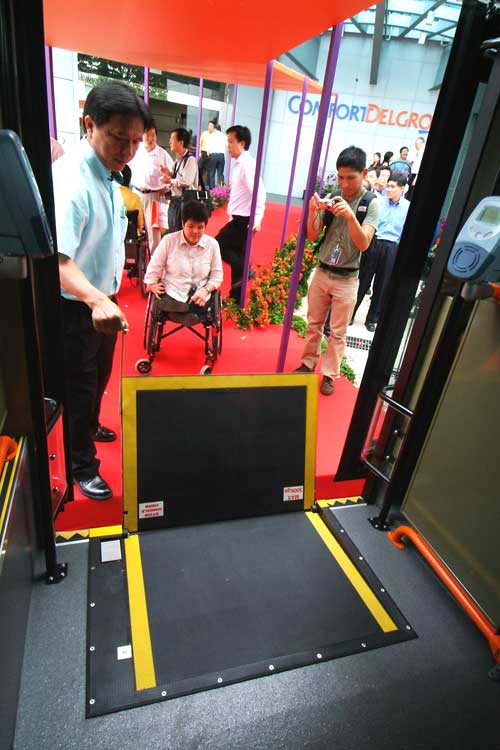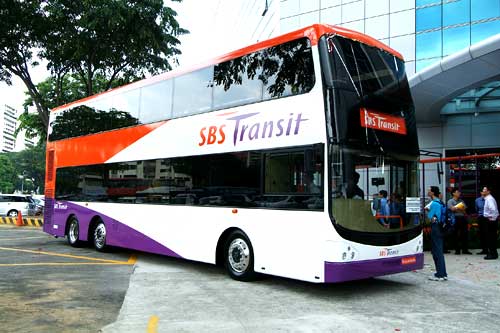Milestones
Singapore Bus Service was formed through the amalgamation of three bus companies - Amalgamated Bus Company, Associated Bus Services and United Bus Company.
A team of Government Technical Officers were seconded to the Company to improve management and improve public transport services.
One-Man-Operation (OMO) system was introduced on selected bus services. Without a conductor, it charged a flat fare with no tickets issued.
Twenty-eight bus terminals were phased out or relocated under the terminal improvement programme. Many moved to major bus interchanges located at the centre of the new towns.
Twenty double deck buses were put on trial to evaluate their suitability on Singapore roads. The first bus was deployed on Service 86.
The first bus interchange was opened at Jurong Road.
Shareholders’ concession passes were introduced.
The Company was listed on the Stock Exchange of Singapore as “Singapore Bus Service (1978) Limited”.
Dual-depot scheme was introduced to reduce dead bus mileage.
First double deck bus was assembled locally at the Company’s workshop at MacKenzie Road.
Information Service Unit, forerunner of the Customer Relations Centre, was set up to respond to passenger enquiries and feedback.
The Company’s headquarters was officially opened at Braddell Road.
Step fares replaced the flat fares charged on OMO services.
First automatic bus washing machine was installed at the Toa Payoh Depot.
National Transport Workers’ Union was formed to represent transport employees.
First Employees’ Collective Agreement was signed with the Union for improvement in staff wages and benefits.
One-man-operation Ticketing System (OTS), which charged graduated fares, was implemented. Tickets were issued by a ticket machine on board.
Concessionary travel for senior citizens was introduced with more than 43,000 senior citizens’ passes issued.
The Company ventured into the taxi business.
A new corporate logo was launched to reflect vibrancy and disciplined strength of the Company.
First air-conditioned bus service was introduced on Service 168.
HASTUS, a computerised bus and crew scheduling system, which cost $1 million, was implemented.
Travel centres were set up for the sale of concession stamps at bus interchanges.
“Singapore Explorer” cards were introduced for tourists to travel conveniently on buses.
Coin changing machines were install at all bus interchanges.
The MRT/bus integration study which covered key recommendations for the rationalisation of bus networks to avoid duplicating resources, and restructuring feeder and truck services to feed into the MRT network, was completed and presented to the Government.
Transit Link Pte Ltd was jointly set up by the Public Transport Operators to work on the integrated fare system for bus and train travel.
Sponsored retro-reflective sashes for School Crossing Monitors in all primary schools.
A “Think Safety” campaign was launched in partnership with the Traffic Police and the Ministry of Education to promote bus and road safety among school children.
The magnetic farecard system commenced trial on selected bus services.
Piped-in music piloted on air-conditioned buses.
The magnetic farecard system was introduced on all trunk routes making cashless travel easy.
Network rationalisation exercise was conducted to integrate bus and train services.
SBS Leisure, incorporated as a fully-owned subsidiary to operate premium quality scheduled bus services, began operating two bus services to Sentosa.
The iconic ‘Superbus’, which was the biggest double deck bus in the world, was unveiled. It was also the first ozone-friendly, air-conditioned, double deck bus in Singapore.
The magnetic farecard system was also implemented on feeder services, marking the full implementation of the system fleet-wide.
Touchscreen multi-media kiosks with SBS Guide were installed at bus interchanges to provide travel information such as the bus guide, fares and service changes.
The Company began shares trading on a scripless basis.
SBS International Holdings Pte Ltd was set up to engage in overseas transport-related investments.
Next Bus Departure Time display monitors were installed at bus interchanges.
AirBus service was launched to serve Changi Airport and the hotels along the Orchard and Marina Centre areas.
Launch of CityCab following the merger between SBS Taxi Pte Ltd and two other taxi operators - Singapore Commuter Pte Ltd and Singapore Airport Bus Service Ltd - to become the second largest taxi company after Comfort Transportation.
First Townlink service was introduced in Tampines New Town. Merged existing feeder services for greater inter-neighbourhood travel.
Website incorporating the SBS Bus Guide was launched to provide information on how to get from point to point.
“Friends of SBS” scheme was introduced, to educate commuters on bus operations and solicit constructive feedback for improvement.
A collaboration with partners transformed a bus into a high-tech computer laboratory known as the Magic Ark, which brought IT to schools and the community centres.
The Company sought separate listing on the Singapore Exchange - Singapore Bus Services Limited was to focus solely on its core business of providing public bus services in Singapore while the parent company became Delgro and continued with its other businesses.
The Route Group concept was introduced for effective bus operations. Each Route Group was in charge of an interchange and the bus services and Bus Captains reporting to it.
Wireless payphone service became available on five services to enable commuters to return pages and make urgent calls while on the move. This was before mobile phones gained popularity.
Bus drivers were addressed as Bus Captains to enhance professionalism in the job.
Licences to operate the North East Line (NEL) and the Sengkang/Punggol Light Rail Transit (LRT) Systems were awarded to the Company by the Land Transport Authority (LTA).
First public transport company to be awarded the People Developer Standard by the Singapore Productivity and Standards Board.
Six Nite Owl services were launched to cater to commuters on late night outings.
SBS Coffee Evenings were initiated at bus interchanges for commuters to provide feedback in a friendly and informal environment.
New uniforms were issued to Bus Captains.
Metroline Limited, a London Bus company, was acquired as part of the Company’s overseas investments.
Singapore Bus Services Limited changed its name to SBS Transit Ltd to reflect its new status as a multimodal transport operator of both bus and train services.
TVMobiles were installed on buses to provide news and entertainment for commuters.
First public transport operator in Singapore to be awarded the ISO 9001 Certification for the provision of bus service and the design of service routes.
Low-floor, zero-step double deck buses were introduced.
First air-conditioned bus interchange was opened at Toa Payoh.
Singapore’s first multi-storey bus park was opened at Soon Lee Road in Jurong.
Ez-link contactless smartcards replaced the magnetic stored value cards. With the new cards, bus fares are automatically calculated and deducted when commuters tap out at the card readers at the exit.
Commuters could access the bus guide via Short Message Service (SMS) on their handphones. They could check on bus routes serving their destinations or request for a point-to-point travel solution.
Twelve buses powered by Compressed Natural Gas went on trial on Service 712, which travelled between Jurong East Bus Interchange and Sakra Avenue on Jurong Island.
NEL was opened for passenger service.
Sengkang East LRT was opened for revenue service.
Sengkang became the second air-conditioned bus interchange to be opened.
Two listed companies - Comfort Group and DelGro Corporation - merged to form ComfortDelGro Corporation Limited, the parent company of SBS Transit Ltd.
Service 160 was launched as the second bus route to provide cross-border service to Johore Bahru.
Security officers were put on duty at NEL stations as part of the enhanced security measures.
The first 150 wheelchair-accessible double deck buses were ordered.
Fast Forward, Chinatown Direct, Parks and Stadium services were launched as non-basic bus services to meet diverse commuters’ needs.
Sengkang West Loop and Punggol East LRT systems were opened for passenger service.
Concessionary travel hours for senior citizens were extended from 9.00 am to end of operations on weekdays and throughout the weekend.
A joint review of remuneration package for Bus Captains was undertaken with the Union as part of the Job Re-creation Programme.
Moove Media Pte Ltd was formed as the advertising arm to handle advertising on buses and trains and stations and interchanges.
First wheelchair-accessible bus service was rolled out on Service 21.
SeasonPass, which provides unlimited bus travels on SBS Transit’s basic bus services was launched at $98.00 a month.
A $42-million Automatic Vehicle Management System which uses satellite technology to locate buses and allow for easier communication between Bus Captains and the Operations Control Centre, made its debut.
NEL’s Buangkok Station was opened for passenger service.
Fifty additional wheelchair-accessible double deck buses were ordered. Together the 200 buses cost $100 million in investment.
100 Euro 4 single deck buses were ordered at a cost of $36 million.
The Intelligent Route Information System, or iris, was rolled out to provide bus arrival timings in real-time on the Internet, through web-enabled mobile devices and via SMS.
Premium Bus Services were introduced to provide a faster and more comfortable ride from the heartlands to the Central Business District during the morning peak hours.
The third air-conditioned, integrated bus interchange was opened at Ang Mo Kio.
The region’s first environmentally friendly Euro 4 buses made its debut.
Another 400 Euro 4 single deck buses were ordered at a cost of $144 million.
Two LRT stations – Oasis and Farmway – on Sengkang West Loop were opened for passenger service.
Retirement age of Bus Captains was raised from 62 to 65 in support of older workers.
400 new single deck buses that meet the Euro 5 Environmentally Friendly Vehicles standards were ordered at a cost of $147 million.
Drivers from China were recruited as Bus Captains.
The Authorities launched the mandatory “Give Way to Buses Exiting Bus Bays” scheme to improve the travel experience for commuters.
The Public Transport Council’s Penalty Fee Regulation was implemented to deter fare evasion.
The Government announced the Land Transport Masterplan to increase public transport usage.
The fourth air-conditioned bus interchange was opened at Boon Lay.
CARES training, aimed at providing better service to customers, was rolled out to include all levels of staff including those in support.
350 new Euro 5 buses comprising 200 single decks and 150 double decks were ordered at a cost of $159 million.
A temporary fare reduction of up to 20 cents and an increase in transfer rebate of up to 50 cents were implemented to help make public transport more affordable for commuters during the economic downturn.
Quality of Service Standard were tightened with 80% of basic bus services and 90% of feeder services to arrive at a scheduled frequency of 10 minutes or less during peak hours.
Distance Fares was launched where fares are based purely on distance travelled.
Two hybrid electric buses were put on trial, which was a first for the public transport industry. Also conducted a brief trial with a hydrogen fuel cell bus.
Iris app for iPhone and Andriod smart phone was launched, attracting 666,000 downloads. Users accessed the app 1.6 million times a day.
Concessionary fares for senior citizens were made available all day.
Serangoon and Clementi air-conditioned bus interchanges were opened for passenger services.
Damai Station on the Punggol East LRT was also opened for service, bringing the seven-station loop to full operation.
Woodleigh Station on the NEL was opened for passenger service, bringing the entire 16-station line to full operation.
Eighteen new trains were ordered for the NEL for delivery from 2015.
600 new Euro 5 buses comprising 300 single deck Citaro buses and 300 double deck Volvo buses were ordered at a cost of $268 million.
Licence to operate the 34-station Downtown Line was awarded to the Company by the LTA.
Cheng Lim Station on Sengkang West LRT system was opened for passenger service.
A free SMS service was launched to alert mobile users to train delays or disruptions on the NEL. For smartphones, a push notification service was introduced on the iris app to provide similar train alert messages.
1,000 new Euro 5 buses comprising 450 single decks and 550 double decks were ordered at a cost of $433 million.
SBS Transit DTL Pte Ltd was incorporated in February as a wholly-owned subsidiary to operate the Downtown Line.
The Government’s $1.1 billion Bus Service Enhancement Programme, which funds 550 new buses on the road, was launched.
Downtown Line Phase 1 started operations on 22 December 2013.
More than 80% of basic bus services are accessible to passengers-in-wheelchairs.
Bus fleet comprises more than 3,300 buses:
- 100% are European-made and fully air-conditioned;
- More than 60% are environmentally friendly; comprising Euro 4 and Euro 5 models; and
- Close to 40% are double deck buses.
Retirement age of staff was raised to 67. Retiring staff who are fit and with good performance records are re-hired at current employment terms.
The Government announced the re-structure of the local public bus industry and the planned transition to a bus contracting model.
iris app’s user interface was enhanced for a better user experience. We also took the opportunity to introduce new features to enhance information access for our users.
“Mobileye”, an advanced driver awareness system, which alerts our Bus Captains to potential collision risks, was put on trial on 70 buses.
A “Hold On!” safety campaign was rolled out to educate and encourage passengers, in particular the senior citizens, to hold onto stanchion poles and hand grips when travelling on buses.
The second phase of the Downtown Line commenced passenger service on 27 December 2015, a day after its opening by Prime Minister Lee Hsien Loong.
70% of our fleet or 2,566 buses are Euro 5 compliant. These environmentally friendly buses will help us to further reduce the amount of harmful emissions into the environment.
All scheduled bus services migrated to the new Bus Contracting Model.
Two-car trains were introduced on our Light Rail Transit systems in Sengkang and Punggol.
SBS Transit won the tenders to operate the Seletar and Bukit Merah Bus Packages, which are the third and fourth bus packages respectively under the Government Bus Contracting Model.
All our bus services were declared wheelchair accessible.
The third phase of the Downtown Line commenced passenger service on 21 October 2017. With DTL3 launched, DTL has 34 stations and a distance of 42km.
The Seletar and Bukit Merah Bus packages commenced operations in March and November, respectively.
The North East Line and Sengkang-Punggol Light Rail Transit systems transitioned to the New Rail Financing Framework.
A trial of Singapore’s first On-Demand Public Bus services commenced with SBS Transit operating two services serving the Joo Koon and Marina-Downtown area. Using a mobile application, passengers could book a ride by requesting to be picked up and dropped off at any bus stop within the defined areas.
Autonomous buses were put on trial on Jurong Island and Sentosa with our Bus Captains trained and deployed as safety operators on board.
The North East Line was honoured with the Ministry of Transport's Inaugural Challenge Shield for being the “Most reliable MRT Line”. It clocked a Mean Kilometres Before Failure of 1.38 million train-km.
The North East Line's Catenary Eye and Overhead Catenary System Video Monitoring system clinched the top spot while the Downtown Line's Track Measurement Trolley was runner-up in the "Best Land Transport Operations and Maintenance Initiatives” category at the Land Transport Excellence Awards.
The Jurong West Bus Package was honoured with the “Safe Bus Operator of the Year (Excellence) Award” while the Downtown Line received the "Safe Rail Line of the year (Merit) Award" at the Land Transport Authority's Annual Safety Convention.
The Ulu Pandan Bus Depot was conferred the Building and Construction Authority (BCA)’s Green Mark Platinum (Super Low Energy) Award.
The expanded Yio Chu Kang Bus Interchange received the BCA Green Mark GoldPLUS Award.
Our entire fleet of more than 3,500 buses was installed with Mobileye, an advanced driver assistance system that alerts Bus Captains to potential collision risks.
A six-month trial involving 25 diesel-hybrid buses was conducted as part of our environmentally friendly efforts with the LTA.
Upgrading works commenced for the mid-life refurbishment of 25 first-generation NEL trains.
Memoranda of Understanding (MOU) were inked with the Taipei Rapid Transit Corporation, RATP Développement S.A. (France) and JR East (Japan) to leverage each other’s skills and experiences in operations, maintenance and engineering.
A trial with LTA and SG Enable commenced for the “Mobility Assistance for the Visually Impaired and Selected Users (MAVIS)” app. This app provides travel assistance to commuters with special needs to make Singapore’s transport network more inclusive.
The MAGIC CARES Van programme was rolled out in partnership with social enterprise, I'm Soul Inc, to reach out to the elderly in the community with music and movements.
The Downtown Line received the “Safe Rail Line of the Year (Excellence) Award" while the Tampines Bus Package received the “Safe Bus Operator of the Year (Merit) Award” at the LTA Annual Safety Convention.
The Singapore Environment Council (SEC) presented us with the Elite Award, the highest tier, in the Eco-Office Plus Certification.
SBS Transit was one of 12 companies in Singapore to be accredited with the GreenDNA Award by the SEC. The accreditation uses an internationally recognised system under the United Nations’ Environment Programme to fight the global climate crisis.
Electrostatic Disinfectant Spray technology was applied on our fleet of buses and trains as part of our stepped-up cleaning and disinfection efforts to keep passengers safe during the COVID-19 outbreak.
Bus Captains were involved in supporting and facilitating the mass transfer of COVID-19 patients between facilities using five dedicated buses that had been converted into the COVID-19 Multi-Passenger Enhanced Transporter.
Forty-five green buses (consisting of 25 hybrid buses and 20 electric buses) were put on trial on behalf of the LTA to assess their suitability on the road.
A Teaming Agreement was signed with RATP Développement S.A., a French public transport operator, to explore new business opportunities and deliver world-class metro services in Singapore.
An MOU was signed with Thales, a French multi-national company, to employ new digital technologies to deliver a safer and more comfortable passenger journey for our MRT passengers.
Engagement sessions were conducted with passengers who were physically and/or visually handicapped and their caregivers to better understand their travel needs as we work towards being more inclusive in our public transport.
Single Deck Bus
The Albion Viking EVK41L
This was one of the buses that plied on Service 93 in the early 1970s.
Length: 31 ft 6 in Width: 8 ft
The Ashok Leyland ALCOP3/1
One of the buses that were used to ply on Service 124 in the early 1970s.
Length: 9.4 m Width: 7 ft 6 in
The Mercedes-Benz OF1413
This bus was used to ply on Service 181 in the late 1970s. Did you see the old SBS logo on the side of the bus?
Length: 11.3 m Width: 2.5 m
Single Deck Bus
The Volvo B57
A relatively long bus with its 11.9 m in length.
Length: 11.9 m Width: 2.5 m
Double Deck Bus
The Leyland Atlantean AN68
This double deck bus was one of the first few introduced in the 1980s.
Length: 33 ft Width: 8 ft ½ in
The Mercedes-Benz O.305
This double deck bus ran on Service 26 from Toa Payoh to Bedok in the 1980s.
Length: 10.6 m Width: 2.5 m
Single Deck Bus
The Scania N113CRB
By the early 1990s, buses were progressively fitted with air-condition, a major improvement from the buses you saw in the 1970s and 1980s.
Length: 11.9 m Width: 2.5 m
The Mercedes-Benz O.405
This bus was one of the buses that were retrofitted with air-condition.
Length: 11.6 m Width: 2.5 m
Volvo B10MA-60 Articulated
SBS Transit only had two articulated buses and this was one of them and with its length, it was Asia’s longest bus. Due to the difficulty in manoeuvring such buses and the fact it took up more road space, SBS Transit has ceased the use of such buses.
Length: 19 m Width: 2.5 m
Double Deck Bus
The Volvo Olympian
Some of these double deck buses can still be seen on the road now as they have yet pass their statutory lives.
Length: 10.5 m Width: 2.4 m
The Leyland Olympian 12 “SuperBus”
This bus was not call “SuperBus” for nothing. It is 12 m long and was the first double deck bus to be fully air-conditioned.
Length: 12 m Width: 2.4 m
Single Deck Bus
The Volvo B10BLE (CNG)
This bus was one of the 12 Compressed Natural Gas fuelled buses SBS Transit introduced in 2002. Apart from being a CNG bus, it is also a low floor bus.
Length: 11.9 m Width: 2.4 m
Scania KUB4X2
It is Singapore's most environmentally friendly public bus. It is also the friendliest to the elderly and disabled - being able to ferry two wheelchair-bound passengers at any one time. And to top it all off, it is also one of the safest - boasting an advanced braking system which helps to minimise on-board accidents.
Double Deck Bus
The Volvo Wright
This batch of double deck buses are built on the Volvo B9TL chassis produced in Sweden and a bodywork made by Wrightbus. The buses will be equipped with environmentally-friendly Euro V engines.
Length: 12m Width: 2.5m
The Dennis Trident III
This batch of double deck buses was all installed with Transit Media LED-type electronic destination screens with orange display.
Length: 12 m Width: 2.5 m
The Volvo B10TL “Super Olympian”
Singapore’s first low-floor Superbus.
Length: 12 m Width: 2.5 m
Volvo B9TL
A prototype of this low-floor step-free double deck bus equipped with a wheel-chair ramp and other physically accessible friendly features was unveiled on 15 February 2006. This is also our first Euro 3 public bus.
Length: 12 m Width: 2.5 m
Single Deck Bus
Mercedes-Benz O530 Citaro
This low-floor, wheelchair-accessible Mercedes bus, built by EvoBus GmbH in Germany, was introduced in 2011. This bus model fulfils the requirements of the Euro V emission standards.
Length: 11.95 m Width: 2.55 m


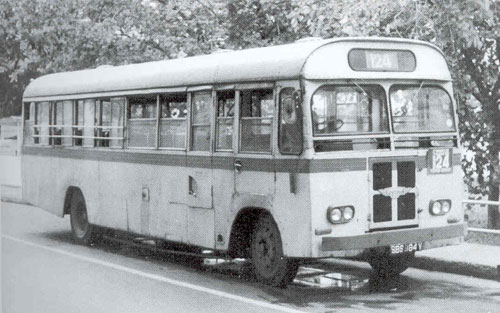
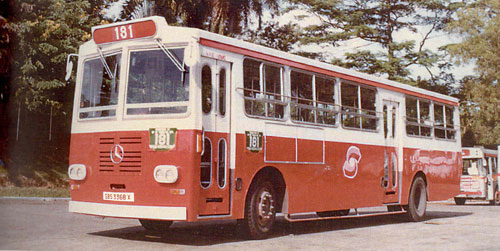
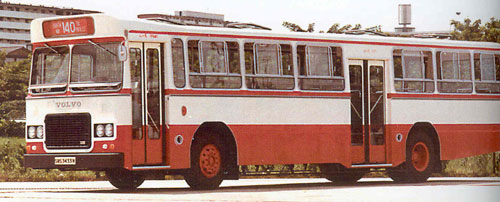

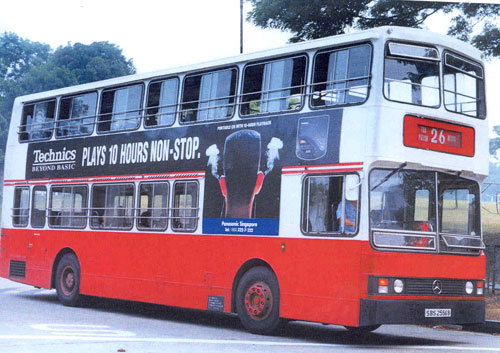
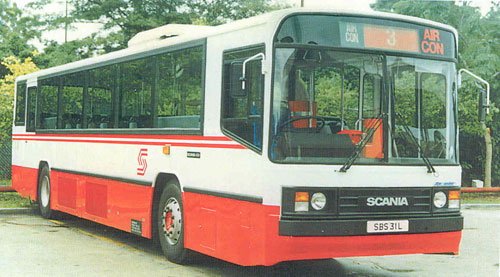
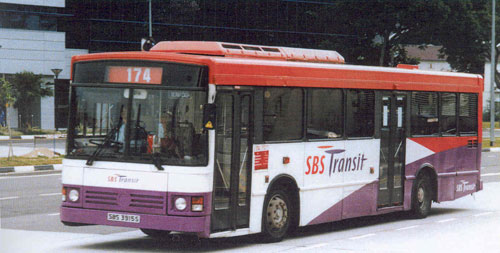
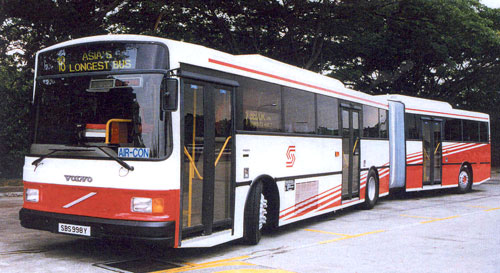
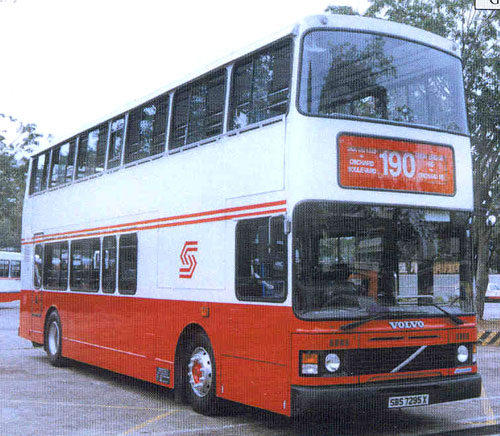
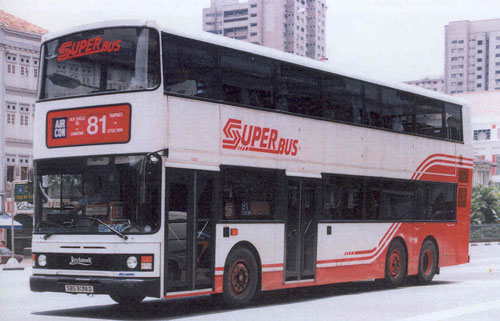
.jpg)



